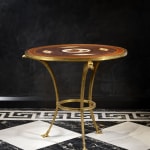Unknown
A fine Russian late eighteenth early nineteenth century gilt bronze and porphyry guéridon, the circular top with a gilt bronze edge inlaid with porphyry with a central painted medallion showing Bellerophon riding on the back of Pegasus in the act of slaying the Chimera, set in a porphyry bed with painted diamond-shaped medallions enclosing paterae with outer painted and porphyry rings, the top on outward scrolled rectangular-shaped tripod supports, each headed by an eagle head, joined by a circular ring and terminated by a bird claw foot
Russia, late eighteenth early nineteenth century
Height 72 cm, diameter 80 cm.
Made in Russia, the design for the tripartite base can be compared with a similarly styled guéridon with tripod supports but with eagle rather than lion heads and claws in place of paws, designed by Andrei Voronikhin (1759-1814), of which there is an example in the Pilaster Room at Pavlovsk Place. The present overall design owes much to the work of the Parisian bronziers from the latter half of the eighteenth century, comparing in particular with examples by François Rémond (1747-1812). Parisian bronzes were very much admired in Russia and inspired their bronziers to produce similar pieces.
The intricate painted and porphyry top features an episode from the life of the Greek hero Bellerophon as told in the Iliad. He was the son of Glaucus, King of Corinth, who while exiled to the court of Proetus caught the attention of the king's wife. When he rejected her advances she reacted by falsely accusing him to her husband of trying to seduce her. Instead of killing him, Proteus sent Bellerophon to his brother-in-law Iobates King of Lycia with a sealed letter stating that the bearer must die. Iobates, who was reluctant to kill his guest himself, decided to send Bellerophon on a series of dangerous feats, in which he hoped that he would meet his death. The first challenge was to kill the Chimera, a fearsome creature that breathed fire and had a lion's head, a goat's body and a serpent's tail. Before he encountered the Chimera, Bellerophon caught Pegasus the winged horse with a golden bridle which Minerva had given him as a gift. Then astride the winged stead he slew the Chimera with his spear. After his initial success Iobates sent Bellerophon on further challenges, one of which was to kill the Amazons which like the others saw Bellerophon as the victor who eventually returned to Iobates and married one of his daughters. This should have been a happy ending but as his fame grew so too did his pride and having enjoyed success with Pegasus, Bellerophon tried to fly on the horse to Mount Olympus. This however incited Zeus's anger who caused Bellerophon to fall to earth, where he spent the rest of his years wandering both blind and crippled.
The present image of Bellerophon however shows the hero at the height of his powers a subject that inspired Rubens' sketch (c. 1635, Musée Bonnat, Bayone) and many ceramic antiquities such as a Greek oil flask of circa 700 B.C. (Boston Museum of Fine Arts) as well as a number of pieces of terracotta, black and white painted Attic and Italiot pottery, which may well have inspired the present choice of colouring. The composition was also most probably derived from Antiquity, comparing for instance with the decoration on an epinetron, an Attic pottery vessel in the National Archaeological Museum, Athens and on an ancient Greek pebble mosaic from Olynthus.



